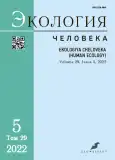Оценка распространенности заболеваний с учетом диагностической эффективности тестов на примере использования серологических тестов для диагностики новой коронавирусной инфекции (COVID-19)
- Авторы: Кригер Е.А.1,2, Гржибовский А.М.1,3,4,5, Постоев В.А.1
-
Учреждения:
- Северный государственный медицинский университет
- Арктический университет Норвегии
- Западно-Казахстанский медицинский университет им. Марата Оспанова
- Казахский национальный университет им. аль-Фараби
- Северо-Восточный федеральный университет им. М.К. Аммосова
- Выпуск: Том 29, № 5 (2022)
- Страницы: 301-309
- Раздел: ОБЗОРЫ
- URL: https://journals.rcsi.science/1728-0869/article/view/108116
- DOI: https://doi.org/10.17816/humeco108116
- ID: 108116
Цитировать
Полный текст
Аннотация
Изучение распространенности заболеваний необходимо рассматривать с учетом результативности тестов, которые используются для их диагностики. В условиях пандемии новой коронавирусной инфекции (COVID-19) лабораторное тестирование является одним из важнейших компонентов общей стратегии профилактики данного заболевания, в том числе и для изучения серопревалентности, позволяющей оценивать уровень популяционного иммунитета. В статье подробно рассматриваются способы расчета и практического применения таких показателей результативности лабораторных методов исследования, как чувствительность, специфичность, прогностическая значимость положительного и отрицательного результатов теста, коэффициента правдоподобия. На примере исследований, изучавших серопревалентность COVID-19, продемонстрировано влияние данных показателей на оценку распространенности и представлена методика ее коррекции с учетом данных о результативности диагностических тестов. Представлен образец синтаксиса для программного обеспечения R, позволяющий провести расчет доверительных интервалов для распространенности с использованием процедуры бутстрепа при известных абсолютных значениях истинно положительных и истинно отрицательных результатов, ложно положительных и ложно отрицательных результатов. Представление скорректированной на показатели результативности распространенности с указанием доверительных интервалов позволяет сопоставить результаты, полученные с использованием разных серологических тестов. Статья предназначена для магистрантов, аспирантов и докторантов медицинских специальностей, чьи исследования связаны с оценкой распространенности заболеваний по результатам популяционных серологических поперечных исследований.
Полный текст
Открыть статью на сайте журналаОб авторах
Екатерина Анатольевна Кригер
Северный государственный медицинский университет; Арктический университет Норвегии
Автор, ответственный за переписку.
Email: kate-krieger@mail.ru
ORCID iD: 0000-0001-5179-5737
SPIN-код: 2686-7226
канд. мед. наук, доцент
Россия, г. Архангельск; г. Тромсе, НорвегияАндрей Мечиславович Гржибовский
Северный государственный медицинский университет; Западно-Казахстанский медицинский университет им. Марата Оспанова; Казахский национальный университет им. аль-Фараби; Северо-Восточный федеральный университет им. М.К. Аммосова
Email: andrej.grjibovski@yandex.ru
ORCID iD: 0000-0002-5464-0498
SPIN-код: 5118-0081
д-р медицины
Россия, г. Архангельск; г. Актобе, Республика Казахстан; г. Алматы, Республика Казахстан; г. ЯкутскВиталий Александрович Постоев
Северный государственный медицинский университет
Email: ispha@nsmu.ru
ORCID iD: 0000-0003-4982-4169
SPIN-код: 6070-2486
канд. мед. наук
Россия, г. АрхангельскСписок литературы
- Институт по измерению показателей здоровья и оценке состояния здоровья (Institute for Health Metrics and Evaluation), Сеть человеческого развития (Human Development Network), Всемирный банк (The World Bank). Глобальное бремя болезней (Global Burden of Disease): порождение доказательств направление политики : региональное издание для Европы и Центральной Азии. Seattle, WA: IHME, 2013. URL: https://www.healthdata.org/sites/default/files/files/policy_report/2013/WB_EuropeCentralAsia/IHME_GBD_WorldBank_EuropeCentralAsia_FullReport_RUSSIAN.pdf
- Byambasuren O., Dobler C.C., Bell K., et al. Comparison of seroprevalence of SARS-CoV-2 infections with cumulative and imputed COVID-19 cases: Systematic review // PloS one. 2021. Vol. 16, N 4. doi: 10.1371/journal.pone.0248946
- Мошкин А.В. Чувствительность и специфичность как клинические индикаторы качества лабораторных исследований // Лабораторная служба. 2020. Т. 9, № 4. С. 5–6. doi: 10.17116/labs202090415
- World Health Organization. Laboratory testing for coronavirus disease 2019 (COVID-19) in suspected human cases: interim guidance, 2 March 2020. URL: https://apps.who.int/iris/handle/10665/331329
- Krajewski R., Gołębiowska J., Makuch S., et al. Update on serologic testing in COVID-19 // Clin Chim Acta. 2020. Vol. 510. P. 746–750. doi: 10.1016/j.cca.2020.09.015
- Yang Y., Yang M., Shen C., et al. Evaluating the accuracy of different respiratory specimens in the laboratory diagnosis and monitoring the viral shedding of 2019–nCoV infections // MedRxiv preprint. 2020. doi: 10.1101/2020.02.11.20021493
- Barchuk A., Shirokov D., Sergeeva M., et al. Evaluation of the performance of SARS--CoV-2 antibody assays for a longitudinal population-based study of COVID-19 spread in St. Petersburg, Russia // Journal of medical virology. 2021. Vol. 93, N 10. Р. 5846–5852. doi: 10.1002/jmv.27126
- Кувшинова И.Н., Некрасов Б.Г., Ливицкая Н.И., и др. Чувствительность и специфичность наборов реагентов АО «Вектор-Бест» для выявления иммуноглобулинов разных классов к SARS-CoV-2 // Справочник заведующего КДЛ. 2021. № 10. С. 27–32.
- Zhao J., Yuan Q., Wang H., et al. Antibody responses to SARS-CoV-2 in patients of novel coronavirus disease 2019 // MedRxiv preprint. 2020. doi: 10.1101/2020.03.02.20030189
- Lou B., Li T.D., Zheng S.F., et al. Serology characteristics of SARS-CoV-2 infection since the exposure and post symptoms onset // MedRxivpreprint. 2020. doi: 10.1101/2020.03.23.20041707
- Cohen A.N., Kessel B. False positives in reverse transcription PCR testing for SARS-CoV-2 // MedRxiv preprint. 2020. doi: 10.1101/2020.04.26.20080911
- Glas A.S., Lijmer J.G., Prins M.H., et al. The diagnostic odds ratio: a single indicator of test performance // J Clin Epidemiol. 2003. Vol. 56, N 11. P. 1129–1135. doi: 10.1016/s0895-4356(03)00177-x
- Fanshawe T.R., Power M., Graziadio S., et al. Interactive visualisation for interpreting diagnostic test accuracy study results // BMJ Evid Based Med. 2018. Vol. 23, N 1. P. 13–16. doi: 10.1136/ebmed-2017-110862
- Leeflang M.M., Rutjes A.W., Reitsma J.B., et al. Variation of a test's sensitivity and specificity with disease prevalence // CMAJ. 2013. Vol. 185, N 11. P. E537–E544. doi: 10.1503/cmaj.121286
- Meyer M.J., Yan S., Schlageter S., et al. Adjusting COVID-19 seroprevalence survey results to account for test sensitivity and specificity // Am J Epidemiol. 2022. Vol. 191, N 4. P. 681–688. doi: 10.1093/aje/kwab273
- Sempos C.T., Tian L. Adjusting Coronavirus prevalence estimates for laboratory test kit error // MedRxiv. Preprint 2020. doi: 10.1101/2020.05.11.20098202
- Lewis F.I., Torgerson P.R. A tutorial in estimating the prevalence of disease in humans and animals in the absence of a gold standard diagnostic // Emerg Themes Epidemiol. 2012. Vol. 9, N 1. P. 9. doi: 10.1186/1742-7622-9-9
- Bendavid E., Mulaney B., Sood N., et al. COVID-19 antibody seroprevalence in Santa Clara County, California // Int J Epidemiol. 2021. Vol. 50, N 2. P. 410–419. doi: 10.1093/ije/dyab010
- Uyoga S., Adetifa I.M.O., Karanja H.K., et al. Seroprevalence of anti-SARS-CoV-2 IgG antibodies in Kenyan blood donors // Science. 2021. Vol. 371, N 6524. P. 79–82. doi: 10.1126/science.abe1916
- Stringhini S., Wisniak A., Piumatti G., et al. Seroprevalence of anti-SARS-CoV-2 IgG antibodies in Geneva, Switzerland (SEROCoV-POP): a population-based study // Lancet. 2020. Vol. 396, N 10247. P. 313–319. doi: 10.1016/S0140-6736(20)31304-0
- Diggle P.J. Estimating prevalence using an imperfect test // Epidemiology Research International. Vol. 2011. P. 1–5. doi: 10.1155/2011/608719
Дополнительные файлы







